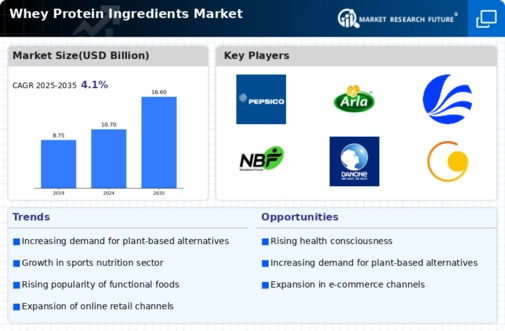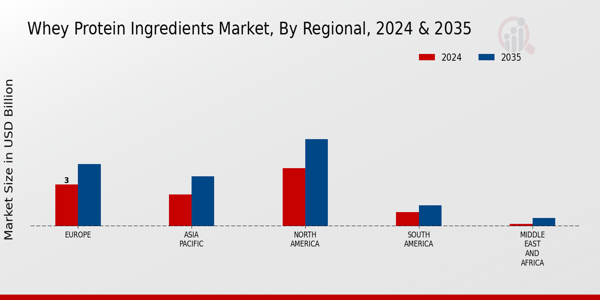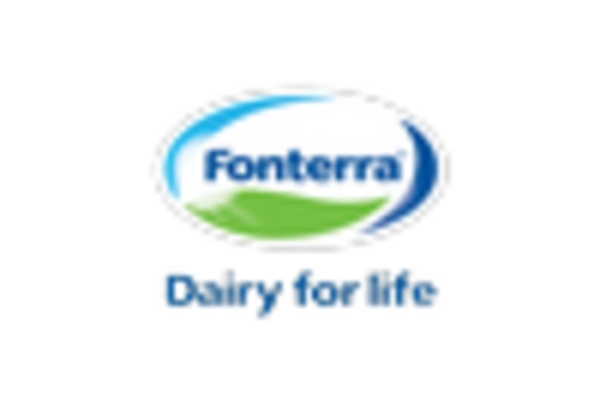Rising Demand for Protein Supplements
The Whey Protein Ingredients Market experiences a notable surge in demand for protein supplements, driven by an increasing awareness of health and fitness. Consumers are increasingly seeking high-protein diets to support muscle growth, weight management, and overall wellness. According to recent data, the protein supplement market is projected to grow at a compound annual growth rate of approximately 8% over the next five years. This trend is particularly evident among athletes and fitness enthusiasts who prioritize protein intake for recovery and performance enhancement. As a result, manufacturers are expanding their product lines to include various whey protein formulations, catering to diverse consumer preferences. This growing demand for protein supplements is likely to propel the Whey Protein Ingredients Market further, as companies innovate to meet the evolving needs of health-conscious consumers.
Growing Popularity of Plant-Based Diets
The Whey Protein Ingredients Market is also influenced by the growing popularity of plant-based diets, which has led to an increased interest in alternative protein sources. While whey protein remains a staple for many consumers, the rise of plant-based protein options has prompted manufacturers to explore hybrid formulations that combine whey with plant proteins. This trend reflects a broader shift towards more sustainable and diverse protein sources, as consumers seek to balance their dietary preferences with nutritional needs. Market Research Future suggests that the demand for plant-based protein is expected to grow significantly, potentially impacting the traditional whey protein segment. However, the unique benefits of whey protein, such as its complete amino acid profile and rapid absorption, continue to position it favorably within the Whey Protein Ingredients Market, appealing to those who prioritize performance and recovery.
Technological Advancements in Production
Technological advancements in production processes are playing a crucial role in shaping the Whey Protein Ingredients Market. Innovations in extraction and filtration techniques have led to the development of higher-quality whey protein products with improved solubility and bioavailability. These advancements not only enhance the nutritional profile of whey protein but also allow for the creation of specialized formulations tailored to specific consumer needs, such as lactose-free or low-fat options. Furthermore, the implementation of automation and precision manufacturing techniques is streamlining production, reducing costs, and increasing efficiency. As a result, manufacturers are better positioned to meet the growing demand for high-quality whey protein products. This focus on technological innovation is likely to drive the expansion of the Whey Protein Ingredients Market, as companies strive to maintain a competitive edge in a rapidly evolving market.
Regulatory Support for Nutritional Products
Regulatory support for nutritional products is emerging as a key driver for the Whey Protein Ingredients Market. Governments and health organizations are increasingly recognizing the importance of protein in diets, leading to favorable regulations that promote the consumption of protein-rich foods. This regulatory environment encourages manufacturers to invest in research and development, resulting in the introduction of new whey protein products that meet safety and quality standards. Additionally, initiatives aimed at educating consumers about the benefits of protein consumption further bolster market growth. As regulations evolve to support the nutritional industry, the Whey Protein Ingredients Market stands to benefit from increased consumer trust and demand for high-quality whey protein products. This supportive regulatory landscape is likely to foster innovation and expansion within the market.
Increased Adoption in Food and Beverage Sector
The Whey Protein Ingredients Market is witnessing increased adoption within the food and beverage sector, as manufacturers incorporate whey protein into a variety of products. This trend is largely attributed to the rising consumer preference for functional foods that offer health benefits. For instance, whey protein is being utilized in protein-enriched snacks, beverages, and dairy products, appealing to consumers seeking convenient and nutritious options. Market data indicates that the inclusion of whey protein in food products can enhance their nutritional profile, making them more appealing to health-conscious consumers. Furthermore, the versatility of whey protein allows for its application in various formulations, from protein bars to smoothies, thereby expanding its market reach. This growing integration of whey protein into food and beverage products is expected to significantly contribute to the growth of the Whey Protein Ingredients Market.


















Leave a Comment